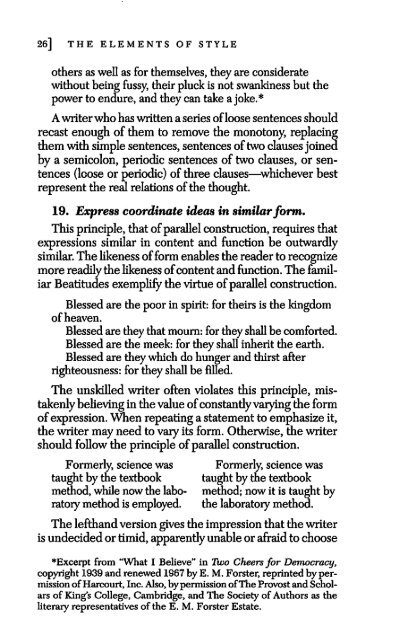Create successful ePaper yourself
Turn your PDF publications into a flip-book with our unique Google optimized e-Paper software.
26] THE ELEMENTS OF STYLE<br />
others as well as for themselves, they are considerate<br />
without being fussy, their pluck is not swankiness but the<br />
power to endure, and they can take a joke.*<br />
A writer who has written a series of loose sentences should<br />
recast enough of them to remove the monotony, replacing<br />
them with simple sentences, sentences of two clauses joined<br />
by a semicolon, periodic sentences of two clauses, or sen<br />
tences (loose or periodic) of three clauses—whichever best<br />
represent the real relations of the thought.<br />
19. Express coordinate ideas in similar form.<br />
This principle, that of parallel construction, requires that<br />
expressions similar in content and function be outwardly<br />
similar. <strong>The</strong> likeness of form enables the reader to recognize<br />
more readily the likeness of content and function. <strong>The</strong> famil<br />
iar Beatitudes exemplify the virtue of parallel construction.<br />
Blessed are the poor in spirit: for theirs is the kingdom<br />
of heaven.<br />
Blessed are they that mourn: for they shall be comforted.<br />
Blessed are the meek: for they shall inherit the earth.<br />
Blessed are they which do hunger and thirst after<br />
righteousness: for they shall be filled.<br />
<strong>The</strong> unskilled writer often violates this principle, mis<br />
takenly believing in the value of constandy varying the form<br />
of expression. When repeating a statement to emphasize it,<br />
the writer may need to vary its form. Otherwise, the writer<br />
should follow the principle of parallel construction.<br />
Formerly, science was Formerly, science was<br />
taught by the textbook taught by the textbook<br />
method, while now the labo- method; now it is taught by<br />
ratory method is employed. the laboratory method.<br />
<strong>The</strong> lefthand version gives the impression that the writer<br />
is undecided or timid, apparendy unable or afraid to choose<br />
*Excerpt from "What I Believe" in Two Cheers for Democracy,<br />
copyright 1939 and renewed 1967 by E. M. Forster, reprinted by per<br />
mission of Harcourt, Inc. Also, by permission of <strong>The</strong> Provost and Schol<br />
ars of King's College, Cambridge, and <strong>The</strong> Society of Authors as the<br />
literary representatives of the E. M. Forster Estate.


